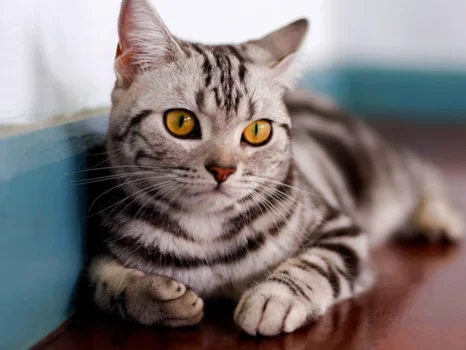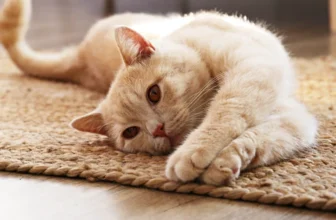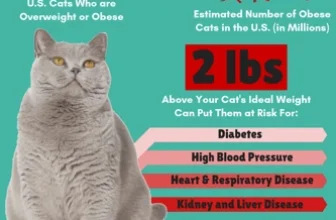As cat owners, we all want our feline friends to live long, healthy lives. Unfortunately, one of the biggest health risks facing American Shorthair cats today is obesity. While it may be tempting to indulge our cats with extra treats and food, overweight cats are at risk of a range of serious health issues that can significantly reduce their lifespan and lead to expensive medical bills. In this article, we’ll take a closer look at the risks of obesity in American Shorthair cats and explore tips and strategies for preventing this common problem.
The Risks of Obesity
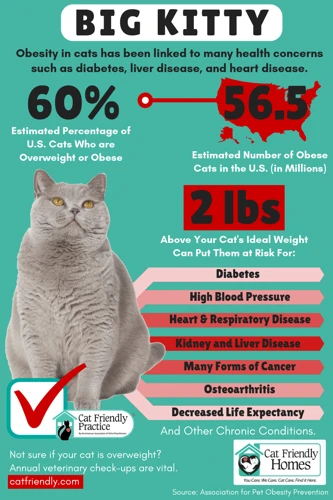
It’s no secret that obesity is a growing epidemic in the United States, and unfortunately that includes our feline friends as well. As an American shorthair cat owner, it’s important to understand the risks associated with obesity and how it can impact your pet’s health and wellbeing. From serious health issues such as feline lower urinary tract disease and arthritis, to increased medical bills and reduced lifespan, the consequences of obesity can be devastating for your furry companion. In this section, we’ll explore the risks of obesity in American shorthair cats in-depth and provide tips for preventing this potentially life-threatening condition.
Health Issues for American Shorthair Cats
Maintaining a healthy weight is crucial for American Shorthair cats, as obesity can lead to a range of health issues. Here are some of the most common health problems associated with obesity in American Shorthair cats:
- Feline Lower Urinary Tract Disease (FLUTD): This disease is more common in overweight cats, especially in males. FLUTD can cause blockages in the urinary tract, which can be life-threatening if not treated promptly.
- Dental Problems: Obese American Shorthair cats are more susceptible to dental problems such as periodontal disease and tooth decay. This is because their excess weight can put extra pressure on their gums and teeth, leading to a higher risk of oral health issues.
- Asthma: Obesity can also exacerbate asthma symptoms in cats, which can be a potentially serious condition. Cats with asthma can experience breathing difficulties, coughing, and wheezing.
- Arthritis: Like humans, cats can suffer from arthritis, particularly as they age. Extra weight puts additional pressure on their joints, leading to inflammation and pain.
- Allergies: Overweight American Shorthair cats may be more prone to skin allergies and other allergic reactions. This is because excess body fat can disrupt the immune system, making it more susceptible to allergic triggers.
- Feline Infectious Diseases: Obesity can also weaken the immune system of American Shorthair cats, making them more vulnerable to infectious diseases such as feline leukemia virus, feline immunodeficiency virus, and feline infectious peritonitis.
- Hairballs: Overweight American Shorthair cats are more likely to develop hairballs, which can cause digestive problems and discomfort. This is because their excess weight can make it more difficult for them to groom themselves effectively.
- Dehydration: Obese cats are at a higher risk for dehydration. This is because their excess body fat can put pressure on their internal organs, causing them to work harder than normal to function properly.
It’s important to remember that obesity can have serious consequences for your American Shorthair cat’s health. Regular wellness checkups with your veterinarian can help catch any potential health issues early on.
Reduced Lifespan
American Shorthair cats that are overweight or obese may face a reduced lifespan compared to healthy weight cats. Obesity increases the likelihood of developing several serious health conditions, such as heart disease, diabetes, and liver disease. These conditions can ultimately shorten the lifespan of your beloved cat. Additionally, carrying around excess weight can put significant strain on a cat’s joints, potentially resulting in arthritis, making it more difficult to move and exercise.
Obesity can also contribute to an increased risk of developing several infections, including feline lower urinary tract disease and other infectious diseases. Prevention of obesity in cats is crucial in warding off these various risk factors that can shorten their lifespan. It’s essential to keep your American Shorthair at a healthy weight through proper diet and regular exercise.
To identify potential health issues that arise with obesity, regular veterinary check-ups are necessary. Going to a veterinarian not only allows you to track your cat’s current weight, but it also helps identify any developing medical concerns such as dental problems, asthma, and other health issues that may have arisen out of obesity. Hence, scheduling regular wellness checkups with your vet can help you better manage your American Shorthair’s health.
While obesity can impact the lifespan of your beloved American Shorthair, it can be prevented through proper diet and exercise. It is essential to keep your cat’s weight in check and reduce the risk of complications that could harm their health. In addition to seeking advice from the veterinarian, pet owners can learn useful techniques like providing a balanced diet and ample playtime that could help maintain the optimal body weight of American Shorthair cats.
Increased Medical Bills
One of the biggest risks associated with obesity in American Shorthair Cats is the increased medical bills that come along with it. As these cats become overweight, they are more prone to a range of health issues, which can result in numerous trips to the veterinarian’s office. These health issues can include diabetes, respiratory problems, arthritis, and even cancer.
Managing these health problems can be both time-consuming and expensive. Pet owners must be vigilant about monitoring their cat’s weight, administering medication if necessary, and providing any necessary medical care. All of this can add up, resulting in an enormous financial burden for pet owners.
To avoid these costly expenses, pet owners can take steps to prevent obesity in their American Shorthair Cats. By providing a balanced diet, regular exercise, and playtime, pet owners can help their cats maintain a healthy weight and avoid these expensive medical bills. Additionally, engaging in regular wellness checkups with their veterinarian can help ensure that any potential health issues are caught early, before they become severe and costly to manage.
It’s important to note that other health issues, such as feline arthritis, allergies, and dehydration, can also result in expensive medical bills. However, by preventing obesity, pet owners are taking a proactive step in reducing the risk of these health issues.
The Causes of Obesity in American Shorthair Cats
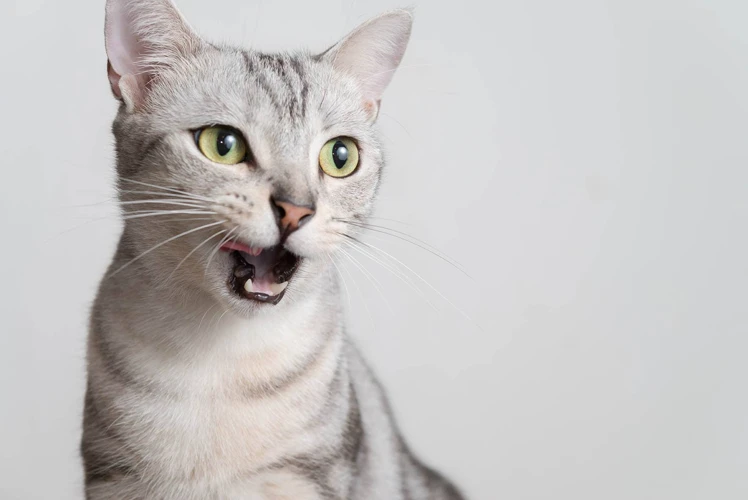
It can be perplexing for pet owners to see their beloved American Shorthair cats struggling with obesity. However, there are various factors that contribute to this health issue. Understanding the root causes can help you take proactive steps to prevent obesity in your cat and help them maintain a healthy weight for a longer, happier life. In this section, we will explore some of the most common causes of obesity in American Shorthair cats. Additionally, if you want to learn more about other health issues that could affect your cat, check out our article on the importance of regular wellness checkups for cats.
Overfeeding
Overfeeding is a major contributor to obesity in American Shorthair Cats. Many cat owners tend to free-feed their cats or offer them larger portions than necessary. This can lead to the consumption of excess calories that the cat’s body cannot burn off. As a result, the extra calories get stored in the body as fat.
Here are some consequences of overfeeding your American Shorthair Cat:
- Obesity: Overfeeding can cause obesity in your American Shorthair Cat, which can lead to other health issues such as arthritis, diabetes, and heart disease. Obese cats are also more prone to develop allergies and hairballs, which can be uncomfortable for them.
- Reduced quality of life: An overweight American Shorthair Cat may face difficulty in performing everyday activities such as grooming themselves, climbing, and playing. Their weight can limit their mobility and cause them to tire easily.
- Increased medical bills: Overfeeding your American Shorthair Cat can result in increased medical bills brought on by obesity-related health issues.
To prevent overfeeding, it’s crucial to measure the portions of food that you give to your American Shorthair Cat. You can either use a measuring cup or scale to ensure that you’re feeding your cat the right amount of food. Additionally, it’s essential to avoid feeding your cat table scraps, which can contribute to excess calorie intake.
If you notice that your American Shorthair Cat is gaining weight despite reducing their food intake, it may be best to consult with your veterinarian. They may recommend specialized diets or supplements to help your cat lose weight.
Remember, overfeeding can significantly impact the health and lifespan of your American Shorthair Cat. By monitoring their food intake and providing them with regular exercise, you can help prevent the risks associated with obesity.
Lack of Exercise
Obesity in American Shorthair cats is generally caused by a lack of exercise. Just like humans, cats need regular exercise to maintain a healthy weight. When cats do not exercise enough and lead a sedentary lifestyle, they are more likely to gain weight. This is especially true for indoor cats who do not have access to the outdoors. If your cat is not getting enough exercise, it’s important to find ways to get them moving.
Here are some tips to help your American Shorthair cat get more exercise:
- Set aside time each day for playtime with your cat. This can include playing with toys, such as balls or feather wands, or even chasing a laser pointer.
- Invest in an interactive toy that requires your cat to move around, such as a puzzle feeder or a scratching post with attached toys.
- Provide your cat with a high perch or cat tree to climb on, so they can climb up and down and get some exercise.
- Encourage your cat to join you in daily activities, such as walking around the house or playing outside in a controlled area.
Getting your American Shorthair cat to exercise may take some effort, but it is an important part of their overall health and wellbeing. By making exercise a part of your cat’s daily routine, you can help prevent obesity and the associated health risks.
If you are unsure about how much exercise your cat needs, or if you are concerned about your cat’s weight, it’s a good idea to consult with your veterinarian. They can provide guidance on how much exercise your cat needs, as well as tips on how to get them moving.
Internal link: For tips on managing feline arthritis in American Shorthair Cats, click here.
Genetics
While overfeeding and lack of exercise are major factors in causing obesity in American Shorthair cats, genetics can also play a role in determining a cat’s susceptibility to becoming overweight. Some cats may have an inherited predisposition to obesity, making it more difficult to maintain a healthy weight even with a balanced diet and regular exercise.
Like humans, cats have unique metabolic rates that affect how much food they need in order to maintain a healthy weight. While some cats may be able to eat more without gaining weight, others may struggle to maintain a healthy weight even with portion control.
Additionally, certain breeds of cats, including American Shorthairs, may have a higher risk of obesity due to their genetics. While this is not a guarantee that every cat of this breed will become overweight, it’s important for owners to be aware of their cat’s individual risk factors.
If you have an American Shorthair cat that seems to be gaining weight no matter how much you control their food and exercise, it may be worth consulting with your veterinarian. They can assess your cat’s overall health and genetics to determine the best approach for weight management. In some cases, medication or other interventions may be necessary to help your cat maintain a healthy weight.
It’s important to remember that while genetics may play a role in your cat’s weight, there are still steps you can take to prevent obesity and promote a healthy lifestyle. By providing a balanced diet, encouraging playtime and exercise, and monitoring your cat’s weight regularly, you can help keep them healthy and happy for years to come.
Stay tuned for more information on how to keep your American Shorthair cat healthy and happy!
Preventing Obesity in Your American Shorthair Cat
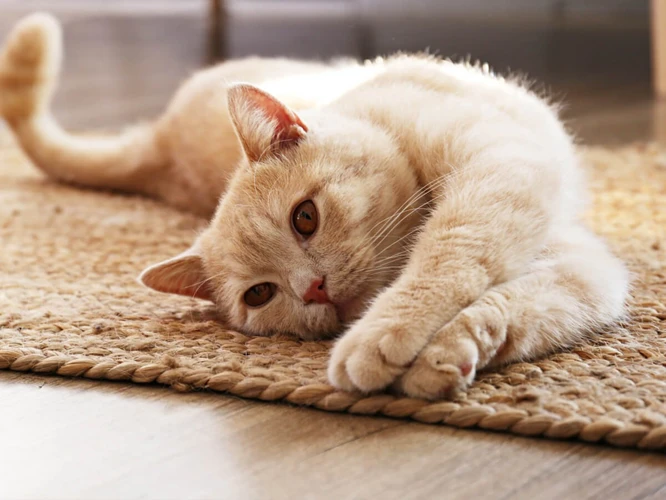
One of the biggest responsibilities of being a cat parent is ensuring that your furry friend stays healthy and happy. Obesity is a common problem among American Shorthair cats, and it can lead to various health issues and reduced lifespan. Luckily, there are many ways to prevent obesity. By following some simple tips and strategies, you can help keep your American Shorthair cat at a healthy weight and reduce their risk of obesity-related health problems. Let’s take a look at some of them.
Choose the Right Amount of Food
It is crucial to choose the right amount of food for your American Shorthair cat to prevent obesity. Overfeeding is one of the top causes of obesity in cats, and can also lead to other health issues. To determine how much food your cat needs, it is important to consider their age, weight, and activity level.
One way to determine the right amount of food is to consult with your veterinarian. They can provide you with a feeding plan specific to your cat’s needs. Another way is to follow the feeding recommendations on the cat food packaging, which typically provide a general guideline for the amount of food to feed your cat based on their weight.
It is important to keep in mind that these recommendations are just a starting point. Every cat is different and may require more or less food depending on their individual needs. You should also consider any health issues your cat may have, such as allergies or hairballs, when selecting their food.
To help keep track of your cat’s food intake, consider using a food measuring cup or a digital kitchen scale. This can help ensure that you are not overfeeding your cat.
| Cat’s Weight | Amount of Food |
|---|---|
| 4-6 lbs | 1/4 to 1/3 cup of dry food OR 3-5 oz of wet food per day |
| 7-9 lbs | 1/3 to 1/2 cup of dry food OR 5-7 oz of wet food per day |
| 10-12 lbs | 1/2 to 3/4 cup of dry food OR 7-10 oz of wet food per day |
| 13-15 lbs | 3/4 to 1 cup of dry food OR 10-12 oz of wet food per day |
By monitoring your American Shorthair cat’s food intake and providing them with the right amount of food, you can help prevent obesity and keep them healthy. In the next section, we will discuss ways to encourage exercise and playtime, which can also help prevent obesity and promote overall health. If you’re interested in learning about managing hairballs in American Shorthair cats, consider checking out our article on managing hairballs in American Shorthair cats.
Invest in Interactive Toys
Interactive toys are not only fun for your American Shorthair cat, but they can also help prevent obesity. These toys provide mental and physical stimulation for your cat, which is important for their overall health. Investing in interactive toys is a great way to keep your cat active and engaged, helping to prevent boredom and reduce the risk of overeating.
There are various interactive toys you can invest in:
| Name of Toy | Description |
|---|---|
| Food maze puzzle | This toy is designed to release small amounts of food as your cat plays with it. The food is hidden inside a maze, which your cat has to figure out how to navigate. |
| Track ball toys | Consist of a ball or two that travel along a track. As your cat swats a ball, it rolls along the track, providing endless entertainment for your cat. |
| Feather wands | A toy that has a feather attached to the end of a string. As you dangle the toy, your cat will jump and swat at the feather. |
| Light beam toys | These toys cast a laser light on the floor or walls which encourages cats to chase after it, providing a fun and interactive game. |
These toys not only encourage exercise and playtime, but they also stimulate your cat’s mind and satisfy their natural hunting instincts. Remember though, it is important to supervise your cat while they are playing with interactive toys to ensure their safety.
In addition to interactive toys, it is also important to provide your American Shorthair cat with scratching posts. Scratching posts can help redirect your cat’s energy away from furniture and carpets and prevent destructive behaviors.
If you notice that your cat is not responding to interactive toys or doesn’t seem interested, don’t worry! Every cat is unique. Try out a different interactive toy or provide a new type of game to peak their interest.
Check out other articles for more information:
Investing in interactive toys is a great way to keep your American Shorthair cat healthy and happy. By providing stimulating activities and keeping your cat entertained, you can help reduce the risk of obesity and other health issues.
Encourage Playtime
It is essential to encourage playtime to prevent obesity in American Shorthair cats. Cats need to engage in physical activity to maintain a healthy weight and prevent boredom and depression. Here are some tips on how to encourage playtime with your lovely feline friend:
| Tip | Description |
|---|---|
| 1. Puzzle feeders | Puzzle feeders are a great way to stimulate your cat’s mind while also providing exercise. There are a variety of puzzle feeders available that will require your cat to work for their food. They will roll, push, and paw at these feeders to get food out, keeping them active and engaged. |
| 2. Cat trees | Cat trees are great for providing a workout and playtime. Cats love to climb and scratch, and a cat tree can help to satisfy those needs. They can climb up and down, scratch the posts, and even nap on the different levels. |
| 3. Feather wands | Feather wands are an excellent way to simulate hunting and playtime. You can dangle the wand in front of your cat, and they will try to catch the feather at the end. It’s an easy way to provide a fun and exciting experience for your cat. |
| 4. Playing hide-and-seek | Playing hide-and-seek can be a great way to encourage exercise. You can hide their favorite toy or treats around the house and let them search for it. It will not only provide exercise, but it also stimulates their mind and helps to keep them mentally alert. |
| 5. Empty cardboard boxes | Cats love to play in cardboard boxes, and it’s a simple way to encourage exercise. They’ll run in and out of the box, jump and scratch on the sides of the box, and even nap inside. It’s a cheap and easy way to provide your cat with playtime. |
By encouraging playtime, you are not only helping your cat maintain a healthy weight but also providing them with mental and physical stimulation. Your cat will be happier, more energetic, and less likely to develop obesity-related health issues.
Monitor Their Weight Regularly
As a cat owner, it is crucial to monitor your American Shorthair’s weight regularly to prevent obesity. Cats with a healthy weight have a long and healthy life, while overweight cats have a higher risk of developing health issues that can shorten their lifespan. Here are some tips for monitoring your cat’s weight:
Weigh your cat: You can track your American Shorthair’s weight by weighing them regularly. Use a digital scale and make note of their weight in a chart. You can also take your cat to the vet for a weigh-in and consultation.
Track their food intake: Keep track of the amount of food your cat is eating daily. By measuring their food, you can ensure that your American Shorthair is not overeating. You can use a simple food measuring cup or kitchen scale to keep portions under control.
Observe their behavior: Watch your cat’s behavior patterns for signs of overeating or decreased activity levels. If you notice changes in their behavior, book an appointment with a vet.
Create a weight chart: By creating a weight chart, you can track your American Shorthair’s weight changes over time. Make a table to record their weight on a weekly basis and plot it on a graph. This way, you can easily recognize any fluctuations in your cat’s weight and take steps to stabilize it.
Monitoring your cat’s weight regularly is crucial to preventing obesity and maintaining their health. By following these tips, you can ensure that your American Shorthair is at a healthy weight and lead a long and happy life.
Provide a Balanced Diet
When it comes to providing a balanced diet for your American Shorthair cat, it’s important to understand their nutritional needs. A cat’s diet should consist of high-quality protein, moderate fat, and low carbohydrates. Here’s a breakdown of what a balanced diet should look like:
| Nutrient | Importance | Recommended Daily Amount |
|---|---|---|
| Protein | Essential for muscle growth and repair | 30-40% |
| Fat | Provides energy and supports healthy skin and coat | 20-30% |
| Carbohydrates | Should be limited as they are not essential for cats | 10-15% |
| Water | Essential for digestion, kidney function, and overall health | Ensure freshwater is available at all times |
When choosing cat food for your American shorthair, look for brands that have high-quality protein sources such as chicken, turkey, or fish. Avoid foods that have fillers such as wheat, corn, or soy as these do not provide much nutritional value for your cat. Additionally, make sure to read the label and check for the recommended feeding amounts based on your cat’s weight and activity level. Overfeeding can lead to obesity and other health problems.
It’s also important to provide a variety of food textures such as wet, dry, and semi-moist to satisfy your cat’s preference and to promote proper digestion. However, if your cat has a specific medical condition, it’s recommended to consult with your veterinarian to choose the best diet for them.
A balanced diet for American shorthair cats should consist of high-quality protein sources, moderate fat, and low carbohydrates. Providing a variety of food textures and reading the label for recommended feeding amounts can help prevent overfeeding and improve your cat’s overall health.
Exercise and Playtime Tips for Your American Shorthair
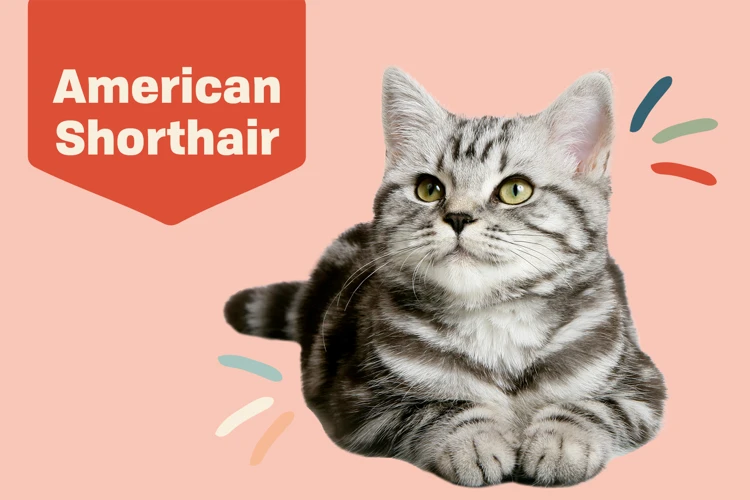
As much as a proper diet is essential, exercise is also necessary for the health of your American Shorthair cat. Regular physical activity not only helps prevent obesity but also keeps your cat mentally stimulated. By engaging in playtime regularly, you can help your furry friend maintain a healthy weight and an overall sense of well-being. Here are some exercise and playtime tips to help you keep your American Shorthair cat healthy and active.
Catnip Toys
Catnip toys, which are infused with the herb nepeta cataria, can be a great way to encourage your American Shorthair cat to exercise and play. Catnip stimulates the receptors in your cat’s brain that are responsible for pleasure and mood, making them more motivated to play. Here are some catnip toy options to consider:
- Interactive catnip toys: These toys often come in the form of plush animals or balls filled with catnip. They can be tossed or scratched and provide stimulation for your cat’s senses.
- Catnip bubbles: This can be a playful way to get your cat to be more active. Blow catnip-infused bubbles and watch as your cat chases them around the room.
- Catnip spray: If your cat isn’t interested in catnip toys, you can try attracting them with a catnip spray. Spray it on their toys, scratching posts, or cardboard boxes to entice them to play.
It’s important to note that while catnip is generally safe for cats, some may have adverse reactions to it. If your cat becomes overly aggressive or lethargic after playing with catnip, it’s best to avoid it. Additionally, it’s recommended to limit your cat’s exposure to catnip to once every few weeks to maintain its effectiveness.
Laser Pointers
Laser pointers can be a fun and effective way to get your American Shorthair cat moving and engaged in playtime. However, it is important to use them safely and effectively to prevent any harm to your pet.
One way to use a laser pointer is to aim it at a toy or treat to encourage your cat to chase and pounce. This not only provides exercise but also stimulates their natural hunting instincts. It is important to never shine the laser directly into your cat’s eyes, as this can cause eye damage. Instead, aim the laser towards the ground or walls.
Another way to incorporate a laser pointer into playtime is to use it in combination with other toys, such as a feather wand or dangling string. This can keep your cat interested and prevent frustration from them being unable to “catch” the laser.
It is important to note that some cats may become obsessed with the laser pointer and develop behavioral issues. To prevent this, limit playtime with the laser to short sessions and alternate with other toys.
By incorporating laser pointers into your cat’s playtime routine in a safe and effective manner, you can provide them with mental and physical stimulation to prevent obesity and improve their overall health.
| Benefits of Laser Pointers in Playtime: |
| – Provides exercise and stimulates natural hunting instincts |
| – Can be used in combination with other toys for added interest |
| – Easy to use and portable |
| Safety Tips for Using Laser Pointers: |
| – Never shine the laser directly into your cat’s eyes |
| – Limit playtime to short sessions and alternate with other toys |
| – Monitor your cat for obsessive behavior and adjust playtime accordingly |
Scratching Posts
Scratching posts are an essential tool in preventing obesity in American Shorthair cats. Not only do they provide an outlet for natural scratching behavior, but they also encourage physical activity.
What are Scratching Posts?
Scratching posts are vertical structures that cats can scratch and climb on. They can be made of various materials, including sisal rope and carpet. They come in different sizes and shapes, but a good scratching post should be tall enough for a cat to stretch out their entire body.
Why are Scratching Posts Important?
Cats have a natural instinct to scratch, and providing them with a scratching post can prevent them from damaging furniture or carpet. It can also help relieve stress and boredom.
How Can Scratching Posts Help in Preventing Obesity?
Scratching posts can provide an opportunity for your cat to engage in physical activity. When they scratch, they are using their muscles. Climbing up and down the post also provides exercise. The more your cat moves, the more calories they burn, helping to prevent obesity.
Choosing the Right Scratching Post
There are many options for scratching posts, and it’s important to choose one that your cat will use. Some cats prefer vertical posts, while others like horizontal scratching surfaces. Experiment with different materials to see what your cat likes best.
Consider the height of the post as well. It should be tall enough for your cat to fully stretch out their body. If you have multiple cats, consider purchasing multiple posts to prevent conflict over resources.
Maintaining Your Scratching Post
Scratching posts can become worn and frayed over time, which may make them less appealing for your cat to use. To keep your cat interested, replace old or worn posts as needed.
Conclusion
Scratching posts can provide a useful outlet for your American Shorthair cat’s natural scratching behavior while also encouraging physical activity. Choosing the right scratching post and regularly maintaining it can help prevent obesity in your furry friend.
Regular Playtime
Playing with your American Shorthair cat regularly is an important part of preventing obesity and keeping them healthy. Here are some tips for incorporating playtime into your cat’s routine:
- Rotate Toys: Cats can get bored with the same toys over time. Keep things interesting by rotating their toys out every few days.
- Use Toys that Encourage Movement: Toys that require your cat to move around and be active are great options for playtime. Examples include feather wands and balls that they can chase and pounce on.
- Get Interactive: Interactive toys, such as puzzle feeders, can be a fun and mentally stimulating way for your cat to play while also getting food rewards.
- Make Time: Even just 10-15 minutes of playtime a day can make a difference. Find a time in your schedule that works for both you and your cat and make it a regular part of your routine.
- Encourage Natural Behaviors: Activities that mimic your cat’s natural behaviors, such as hunting and stalking, are great options for playtime. Try using toys that resemble prey for your cat to chase and pounce on.
Regular playtime not only helps to prevent obesity, but it also strengthens the bond between you and your American Shorthair cat, keeping them happy and healthy. By incorporating fun and interactive activities into their routine, you’ll be taking an important step towards ensuring their long-term well-being.
What to Avoid
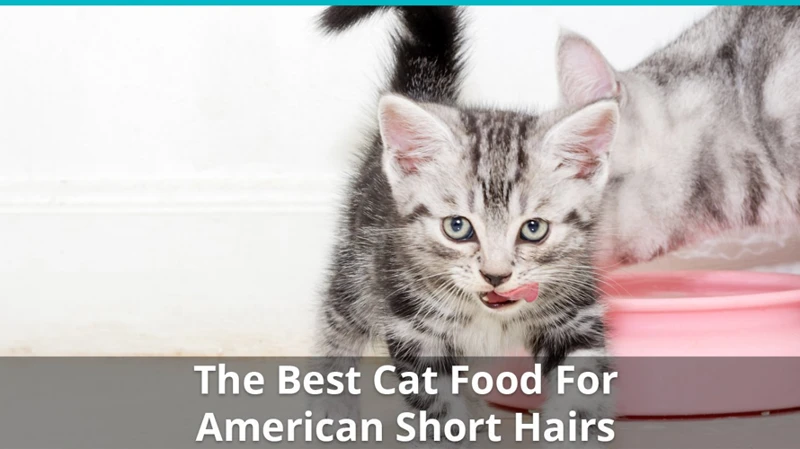
As much as knowing what to do is important, knowing what to avoid is just as crucial when it comes to preventing obesity in American Shorthair cats. Making simple mistakes or not being aware of certain factors can lead to the opposite of the desired outcome. In order to ensure you are helping rather than hindering your cat’s health, it’s important to take note of the following factors to avoid.
Free-feeding
Free-feeding is a common mistake made by many American Shorthair cat owners. This practice involves leaving out a constant supply of food for your cat to eat at their leisure. While it may seem convenient, it can lead to overeating and ultimately obesity.
Why is free-feeding problematic?
Cats are natural grazers and will eat when they feel hungry. However, free-feeding leads to overeating as cats are unable to regulate their own portion sizes. Additionally, leaving food out all day increases the risk of spoilage and attracts insects and other pests.
What are the negative effects of free-feeding?
Overfeeding can lead to obesity which puts your cat at risk for a number of health problems such as diabetes, joint issues, and heart disease. A cat that is overweight may have a shorter lifespan and be more prone to medical bills due to ongoing health issues.
What are the alternatives?
Instead of free-feeding, offer your American Shorthair cat smaller portions throughout the day. This can help regulate their food intake and prevent overeating. Alternatively, consider investing in an automatic feeder that will dispense specific amounts of food at designated times throughout the day.
How can you encourage your cat to eat on a schedule?
Establishing a feeding routine may take time, but there are a few tricks you can use to encourage your cat to eat on a schedule. Try placing your cat’s food in a quiet area away from distractions such as loud noises or other pets. Provide your cat with a set amount of time to eat their food (approximately 20 minutes) before removing it if they haven’t finished.
| Pros of Feeding on a Schedule | Cons of Free-feeding |
|---|---|
| Prevents overeating and obesity | Encourages overeating and obesity |
| Reduces risk of food spoilage and pests | Increases risk of food spoilage and pests |
| Establishes a routine for your cat | Does not establish a routine for your cat |
Free-feeding is a practice that should be avoided to prevent obesity and promote a healthy lifestyle for your American Shorthair cat. By establishing a feeding routine and providing appropriate portions, you can ensure that your cat maintains a healthy weight and avoid potential health issues down the line.
Foods High in Carbohydrates
One of the biggest culprits when it comes to American Shorthair cat obesity is their diet, particularly consuming foods high in carbohydrates. Carbohydrates are a great source of energy for humans and some animals, but cats are different. In the wild, cats are obligate carnivores, which means their bodies are adapted to gain energy from protein and fat.
When cats consume foods high in carbohydrates, their bodies are not designed to process them effectively. This can lead to weight gain and a variety of other health issues. It is important to read the labels on your cat’s food and avoid any products that are high in carbohydrates and fillers.
Some foods high in carbohydrates that you should avoid giving to your American Shorthair cat include:
- Corn: Corn is a common filler ingredient in many cat foods. It is high in carbohydrates and not a natural part of a cat’s diet.
- Wheat: Like corn, wheat is often used as a filler ingredient in cat food. It is high in carbohydrates and can lead to weight gain and other health issues.
- Rice: While rice is a staple in many human diets, it is not a natural part of a cat’s diet. It is also high in carbohydrates and can contribute to weight gain in cats.
- Potatoes: Potatoes are a common ingredient in many cat foods, but they are also high in carbohydrates. They should be avoided if possible to prevent obesity in your American Shorthair.
It is important to note that not all carbohydrates are bad for your cat. Vegetables such as spinach, carrots, and broccoli can provide beneficial nutrients to your cat’s diet without contributing to weight gain. However, these should be included in moderation to maintain a balance in their diet.
It is crucial to monitor your American Shorthair cat’s diet closely and avoid feeding them foods high in carbohydrates and fillers. Instead, opt for high-quality cat foods that have a higher protein and fat content, and consult your veterinarian for recommendations on the best diet for your cat. By taking a proactive approach to their diet, you can help prevent obesity and keep your American Shorthair healthy and happy.
Sedentary Lifestyle
A sedentary lifestyle is one of the major contributors to obesity in American Shorthair cats. These cats have a natural instinct to hunt and play, and when they are not given enough opportunities to indulge in physical activity, they become prone to weight gain. It’s important to recognize signs of a sedentary lifestyle and take steps to address them.
Signs of a Sedentary Lifestyle
| Signs | Description |
| Lack of interest in playing | If your cat seems uninterested in playing, or spends most of her time sleeping, she may not be getting enough exercise. |
| Excessive grooming | Cats that aren’t active tend to groom themselves more often, which can be a sign of boredom and lack of stimulation. |
| Difficulty jumping or climbing | If your cat has trouble getting up on furniture or jumping down from heights, it may be a sign that she is not getting enough exercise. |
| Weight gain | A sedentary lifestyle can lead to weight gain, which can cause a variety of health problems. |
How to Address a Sedentary Lifestyle
There are many ways to address a sedentary lifestyle in American Shorthair cats. One of the most effective strategies is to create a stimulating environment that encourages physical activity and play. This can be done by providing your cat with a variety of toys and play structures, and by engaging her in interactive playtime regularly.
Another strategy is to make sure your cat has access to plenty of vertical space. This can be achieved by installing cat trees or shelves around your home, which will encourage your cat to jump and climb. Additionally, providing your cat with scratching posts can help her stay active and healthy.
Finally, it’s important to be mindful of your cat’s diet and to make sure she is getting the right amount of food. Overfeeding can be a major contributor to weight gain in cats, so it’s important to measure your cat’s meals and to avoid free-feeding. With these strategies in mind, you can help your American Shorthair cat live a healthy and active lifestyle.
Consulting With Your Veterinarian
It’s important to consult with your veterinarian regarding any concerns or questions you have about your American Shorthair cat’s weight and obesity. Your veterinarian can provide you with more personalized advice based on your cat’s individual needs, health history, and lifestyle.
During your visit, your veterinarian can assess your cat’s health and weight, and help you determine the appropriate feeding and exercise regimen for your cat. They may also be able to recommend specific types of food or supplements that can promote weight loss and overall health.
In addition to providing advice and guidance on preventing obesity, your veterinarian can also identify any potential underlying health issues that may be causing your cat’s weight gain. These issues can include thyroid problems, diabetes, or other hormonal imbalances that can affect your cat’s weight and overall well-being.
If your cat is already overweight or obese, your veterinarian may also recommend a weight loss plan that includes a combination of dietary changes and exercise. They may also provide regular check-ins to monitor your cat’s progress and adjust the plan as needed.
Remember, prevention is key when it comes to obesity in American Shorthair cats. By working with your veterinarian and following the prevention tips and strategies outlined in this article, you can help keep your cat healthy, happy, and at a healthy weight.
Conclusion
After going through the risks and causes of obesity in American Shorthair cats, it’s clear that prevention is key. As responsible pet owners, we need to make sure that we are doing everything possible to help our furry friends maintain a healthy weight and live a long, happy life.
Choosing the right amount of food is crucial in preventing obesity in American Shorthair cats. Overfeeding and free-feeding can both lead to weight gain and a host of related health problems. Providing a balanced diet with the right mix of nutrients is important, and consulting with your veterinarian can help ensure that your cat is getting the right food for their individual needs.
Investing in interactive toys and encouraging playtime can make a big difference in your cat’s activity level. Cats love to play and hunt, so providing toys that simulate that experience can be very helpful in keeping them active and engaged. Regular monitoring of weight is also important, so that any changes can be caught early on and addressed before they become a problem.
It’s important to avoid free-feeding, as this can lead to overeating and obesity. It’s also best to avoid foods high in carbohydrates, as these can contribute to weight gain and other health issues. Your cat’s diet should be focused on protein and healthy fats, and should provide the energy needed for an active lifestyle.
Finally, it’s important to consult with your veterinarian if you have any concerns about your cat’s weight or activity levels. Your vet can provide guidance and advice on the best course of action for your individual cat, and can help you develop a plan for keeping them healthy and active.
In conclusion, preventing obesity in American Shorthair cats is essential for their overall health and wellbeing. By choosing the right amount of food, providing plenty of exercise and playtime, avoiding free-feeding, and consulting with your vet, you can help your furry friend maintain a healthy weight and live a long, happy life.
Frequently Asked Questions
1. How much should I feed my American Shorthair cat?
The amount of food your cat needs varies depending on factors such as their age, weight, and activity level. Generally, a healthy adult cat needs about 24 to 35 calories per pound per day, and it’s best to divide that into two or three small meals. Consult with your veterinarian to determine the optimal feeding amount for your cat.
2. What are some signs that my cat is overweight?
Common signs of obesity in cats include difficulty jumping or running, a visible lack of a waistline, and difficulty grooming hard-to-reach areas such as the back. Additionally, if you can’t feel your cat’s ribs without pressing hard, it’s likely they’re carrying extra weight around.
3. Can genetics play a role in my cat’s weight?
Yes, just like humans, genetics can play a role in a cat’s weight. Some cats may have a slower metabolism or a predisposition towards overeating, which can make it more difficult for them to maintain a healthy weight. However, a balanced diet and exercise regimen can still help manage weight even in cats with genetic predispositions towards obesity.
4. Are there any specific types of food that can help prevent obesity in cats?
There are numerous types of cat food available that are specifically formulated to promote healthy weight. These tend to have an appropriate balance of protein and fat, as well as fiber to help your cat feel full. Look for brands that specifically advertise weight management formulas, and consult with your veterinarian for recommendations.
5. Can treats play a role in my cat’s weight?
Yes, treats can contribute to weight gain in cats just like in humans. It’s best to limit treats and choose low-calorie options, or even small amounts of your cat’s regular food as a treat. Additionally, you can incorporate treats into playtime to encourage exercise.
6. Can American Shorthair cats be prone to certain health issues associated with obesity?
Yes, American Shorthair cats, like all cats, can be prone to health issues such as diabetes, joint problems, and heart disease, which can be exacerbated by excess weight. Keeping your cat at a healthy weight through proper nutrition and exercise can help mitigate these risks.
7. How can I encourage my cat to exercise and play?
There are numerous toys and activities you can use to encourage your cat to play, such as catnip toys, laser pointers, and scratching posts. Additionally, making playtime a part of your daily routine can help your cat get used to and enjoy regular exercise.
8. How often should I weigh my cat?
It’s a good idea to weigh your cat regularly, ideally once per month, to track their weight over time and ensure they’re maintaining a healthy weight. This can be done at home with a pet scale, or you can take them to the veterinarian for a weigh-in.
9. What are the risks of free-feeding my cat?
Free-feeding, or leaving food out all the time for your cat to graze on, can contribute to overeating and obesity. Additionally, it can make it more difficult to monitor your cat’s food intake and ensure they’re getting the right amount of nutrition. Instead, opt for portioned meals and remove any uneaten food after a certain amount of time.
10. What should I do if I suspect my cat is overweight?
If you suspect your cat is overweight, consult with your veterinarian to determine the best course of action. Your vet may recommend specific diet and exercise changes, or they may want to run tests to rule out any underlying health issues that could be contributing to the weight gain.

